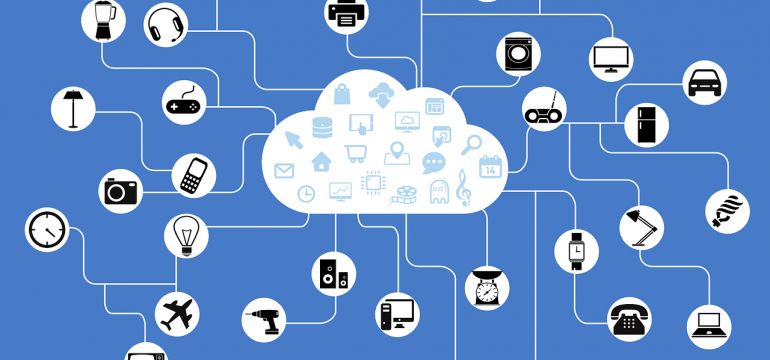The visionary concept of smart homes was conceived decades ago, but thanks to the technical limitations of infrastructure and technology, this vision was just a dream for the average home owner. Until now. Automated homes are now here thanks to the mass deployment of high-speed broadband connections, the proliferation of wireless syncing technology and the mass adoption of billions of handheld smart devices that are connected 24/7.
Once these automated homes are mass deployed and the technology behind them is perfected, the revenue opportunities for device manufacturers, builders and service providers promise to be over the top. Security experts have predicted that the home automation industry is primed to grow to $490 billion by the year 2019. By all aspects, this seems like a largely undervalued figure.
All things connected – What is a smart home?
In the simplest of terms, a smart home or an automated home is one that is built and designed to deliver to the home owner a range of services and amenities that can be controlled via a plethora of inter-connected devices. These services can be regulated by the home owner from inside or the outside, thanks to the always connected nature of these amenities. While the exact definitions of smart homes can change thanks to the technology and services in question, the fundamental qualities of automated homes remain the same. In essence, by sharing information with each other, each component within a smart home becomes a part of the Internet of Things (IoT).
As technology has progressed, the nerve center of a smart home has become one central hub from where all aspects of the connected devices within the home can be checked and altered by the home owner. This is in stark contrast to the nascent theories which exist about automated homes – wherein every device within the home is connected to the Internet but functions independently. This gives the smart homes of today central control, which makes it easier for designers and marketers to leverage revenue opportunities as well.
#IoT Samsung SmartThings: Home is where the SMART is https://t.co/c34Dj0yV3f #SmartHome
— Internet of Things (@Things_Internet) March 6, 2016
Key components and systems of a smart home
Since a home automation system integrates all embedded electrical appliances with each other, here are certain categories of smart devices:
- Home entertainment systems – This includes your home theater system, gaming consoles, sound systems, eBook readers and other audio/video devices.
- Lighting control systems – This includes an intelligent network based lighting system that senses presence or movement. This contributes towards energy savings and predictive light control.
- HVAC control systems – Through a central duct, heating, ventilation and air conditioning (HVAC) systems can regulate the temperature within the home. An Internet controlled thermostat can allow remote control over the internal temperature.
- Yard watering systems – This allows water faucets and sprinklers to turn on and off automatically so as to enable the watering of yards or gardens.
- Interior shading systems – By automatically regulating the blinds and curtains within the home, goals of temperature control, brightness control, glare control, security, privacy and presence simulation can easily be met.
- Security systems – These tools can lock and unlock the doors of the home when the owner leaves or returns. Smoke detectors can also force lockdowns in case a hazardous situation arises. Security cameras and protocols can be established so as to monitor the home at all times and see evidence in case an intruder breaks in.
- Other systems – With the right hardware and software, any household appliance can be connected and controlled automatically or remotely. This includes swimming pool systems, cooking appliances and more.
All in a day’s work – Life in a smart home
5.30 AM
Your home adjusts the internal temperature based on the outside weather stats it collects and the weather prediction for the rest of the day.
It then syncs your calendar for the day and gently wakes you up with a soothing alarm and parting curtains.
6.30 AM
Based on your fitness goals and calorie intake count for the week, your breakfast is suggested to you and all you have to do is put it together.
Your refrigerator checks what items you consumed and automatically updates your grocery shopping list for the evening. This list can be accessed on your phone or other devices.
7.30 AM
When you are ready for work you just walk out, and your home automatically locks up and turns all switches off behind you. You can also check online if you accidentally left something on, and can turn it off during your commute to work.
10.00 AM
You are at work and hear about the latest Batman game from your colleagues. You remotely switch on your PlayStation and purchase and install the game to keep it ready for you once you return.
12.00 PM
Your mobile, cable, electricity and other utility bills are automatically paid off with one single command. You can check your usage stats and outstanding amounts in a small two-minute window between meetings.
3.00 PM
You receive a notification that there seems to be an intruder in your front yard. You switch on the camera from your phone and see that it’s just your neighbor’s dog ruining your grass again.
6.00 PM
You head to the local grocery store and get all the items from the list that was synced by your refrigerator in the morning. You simply load the items in your cart and walk out and the store’s NFC sensors charge you money directly from your mobile wallet. Your grocery list is accordingly updated and your refrigerator can breathe a sigh of relief.
7.00 PM
You enter the house without a key and all the lights and electrical appliances switch on thanks to the ambient sensors. The restroom automatically heats up some water for a refreshing shower.
7.30 PM
Your dinner menu is suggested to you based on your preferences and you get it all together. If you are in the mood to try something new, the recipe immediately comes up with a quick voice search.
8.30 PM
You play through the installed Batman game for an hour or so and share the progress with your friends. The game lives up to the hype.
9.30 PM
You sync up your calendar for the next day and get your lists in order and set your planner for the day.
10.00 PM
Your bedside E-Reader opens your favorite book from the page you last left it at.
10.30 PM
As you drift off to sleep, your lights dim down and eventually turn off. Your sleep patterns and movements are also recorded so that you can view them later.
Predictions and trends about smart homes
Here are some notable predictions about the future of the smart homes market and what this means for vendors who will manufacture and supply these smart home devices.
- Smart home device shipments will grow at a compound annual rate of 67% over the next 5 years.
- Devices shipped will hit the 1.8 billion units mark by 2019.
- The smart homes category will make up about 25% of shipments within the IoT category.
- Smart homes device sales will reach $61 billion in revenue this year. This will grow at a 52% compound annual growth rate to $490 billion by 2019.
All these stats are from a Business Insider Intelligence report on “The Connected Home – Forecasts and Growth Trends for the Leading ‘Internet of Things’ Market”
Conclusion
While all this fancy talk certainly tickles the imagination, the reality could be a bit different when it comes to automated homes. For instance, if devices from competing companies are incompatible and do not talk to each other, it could disrupt the entire flow of information. Moreover, these gadgets and devices could actually leak confidential information about people to advertisers which may or may not be a pleasant experience. The biggest risk could also come from the distinct possibility that a smart home’s system could get hacked and an outsider could control every intricate detail with malicious intent.
However, it certainly does not have to be this way. There is no reason why an automated home cannot be completely controlled solely by the home owner and not some middleman in the cloud. As the Internet of Things slowly permeates into automated homes around the world, and as commercially large building projects sell people on early smart home products, this market is still waiting for that one cohesive option that does not require a corporate overseer.





